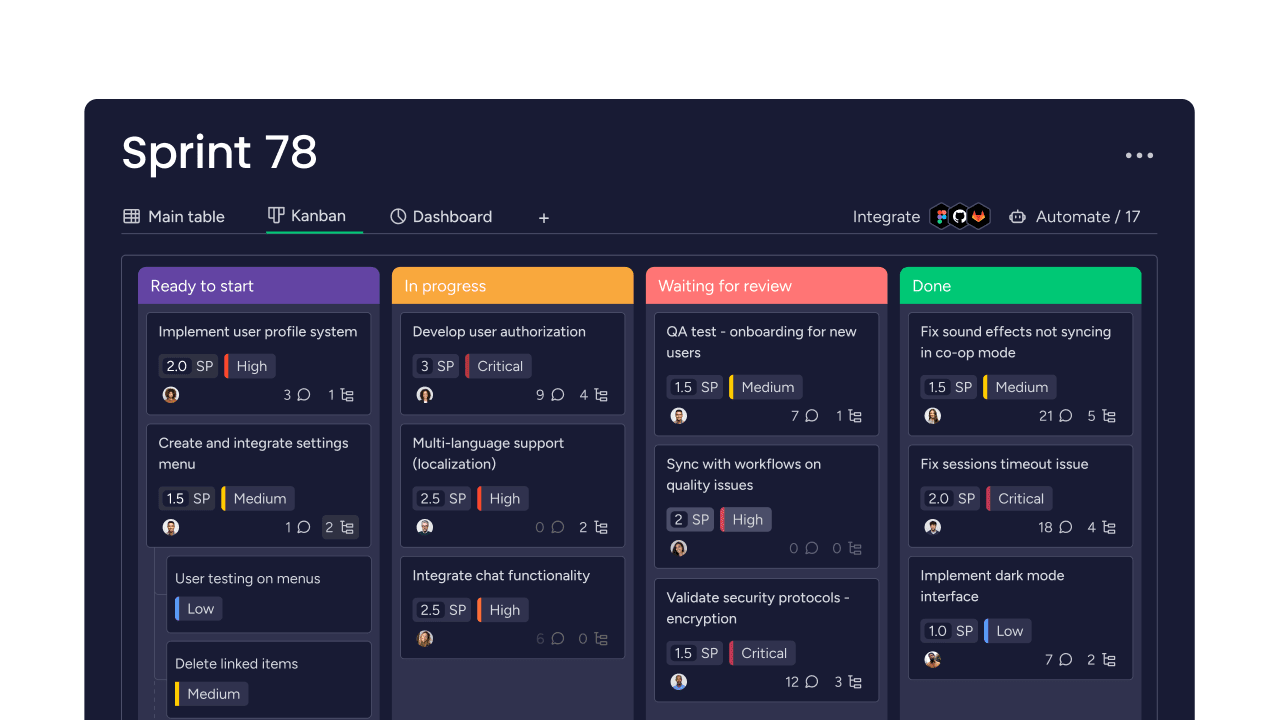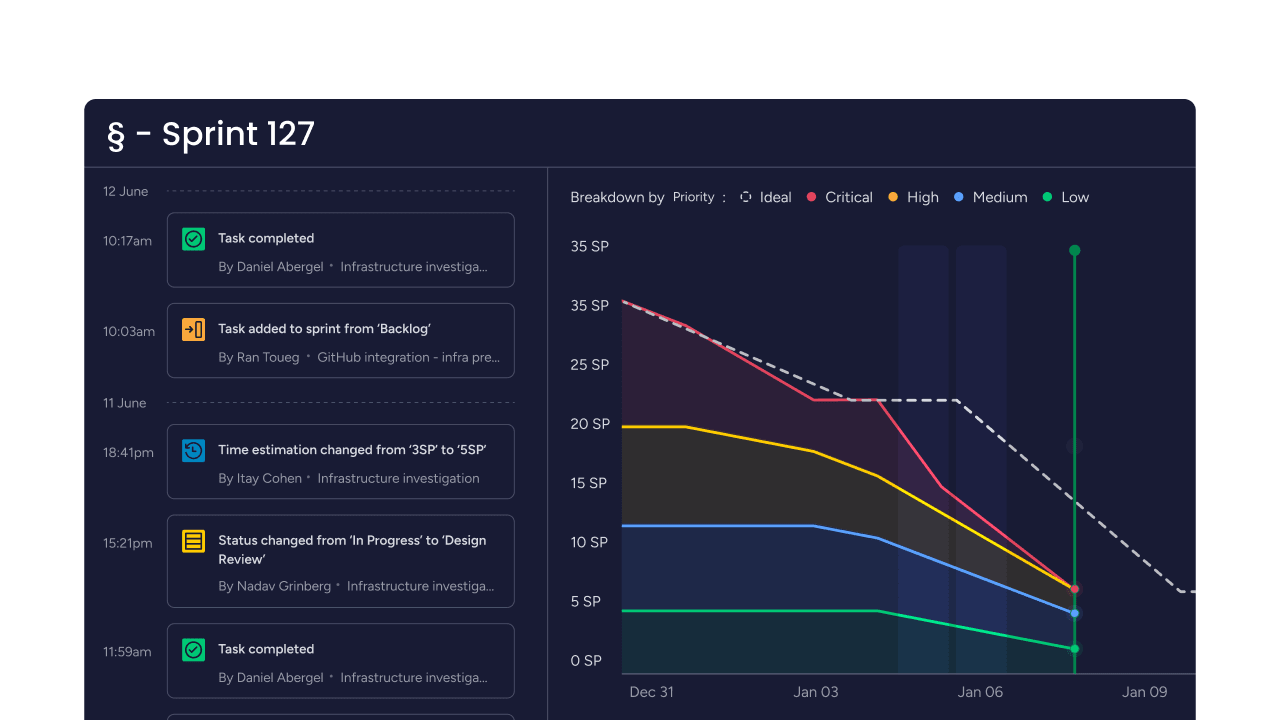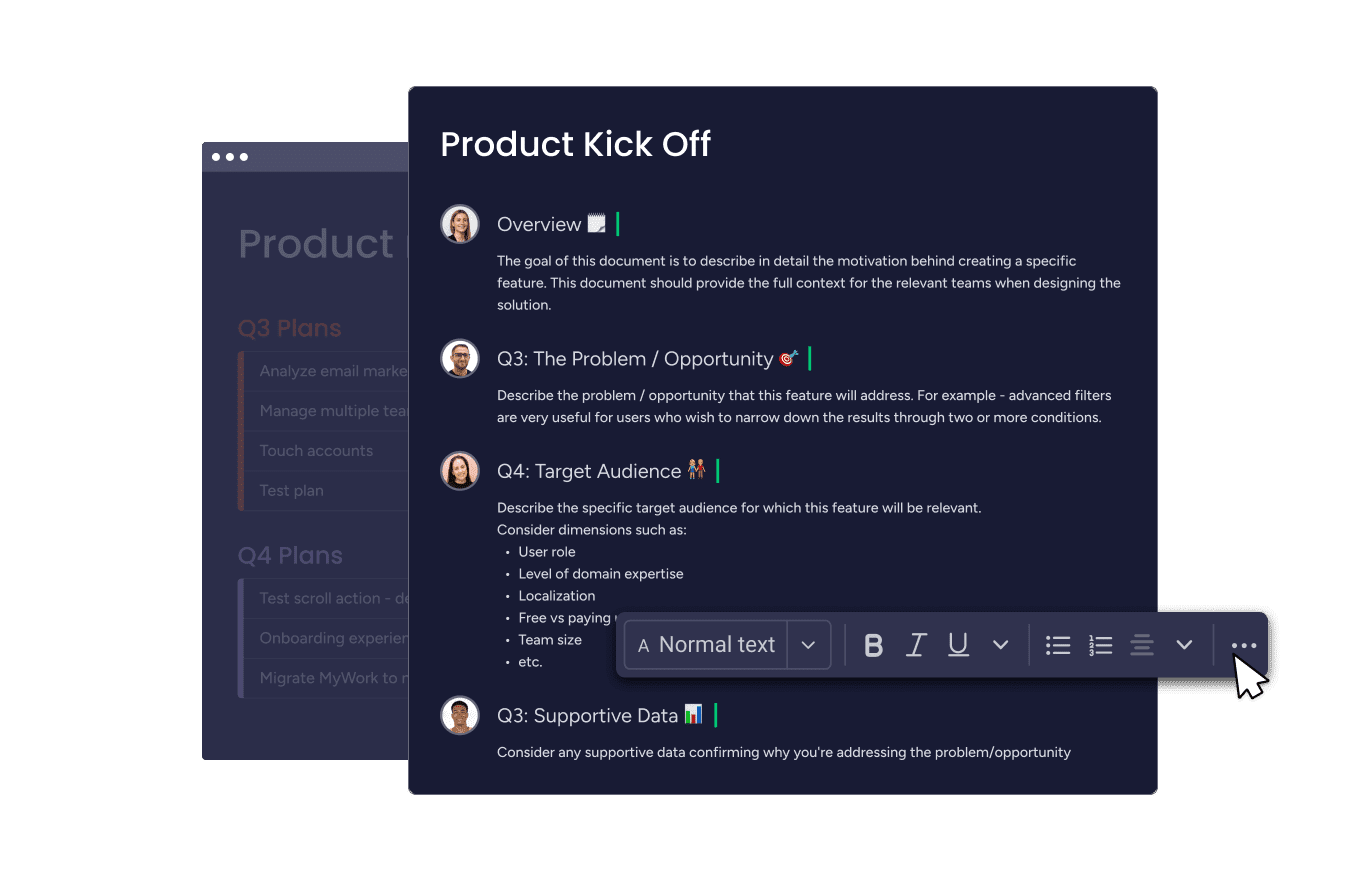Sprints are part and parcel of the Scrum framework. Each short burst is influenced by the success or shortcomings of the previous sprint, driving the continuous improvement and refinement of your product.
This guide examines the importance of Agile sprint reviews in analyzing each product increment and deciding how to approach the next. We’ll explain who attends these meetings, how they differ from other Scrum ceremonies, and highlight 10 best practices when hosting yours. To keep everything organized, we’ll also show you how to use monday dev to manage your sprints.
Try monday devKey takeaways
- Sprint reviews are essential Agile ceremonies that help teams showcase work, gather feedback, and adapt product goals at the end of each sprint.
- These meetings involve the entire Scrum team, including stakeholders, to foster shared understanding, rapid learning, and collaboration.
- An effective sprint review process features preparation, demonstration, open feedback, backlog updates, and clear next steps for each cycle.
- Overcoming common challenges — like low attendance and lack of engagement — requires setting clear agendas, encouraging open discussion, and keeping reviews interactive.
- Enable Agile workflows, real-time reporting, live feedback, automated action item tracking, and seamless backlog prioritization with AI-powered software like monday dev.
What is a sprint review?
A sprint review is a meeting at the end of every Scrum sprint in your Agile development cycle. The team uses this time to showcase the work they’ve completed during the sprint. Think of it like “show and tell” with a twist. You’ll also use the time for :
- Gathering feedback from stakeholders
- Ensuring alignment with the project’s direction
- Updating product backlog items for future adaptations
By reviewing the work done and gathering insights from your key stakeholders, these highly collaborative meetings ensure your Scrum team is always building something meaningful that meets customer and business needs.
Why sprint reviews matter in Agile development
Sprint reviews are an essential part of the Agile development process — they drive continuous improvement, transparency, and close collaboration between teams and stakeholders. By regularly showcasing completed work, collecting feedback, and updating the product backlog, sprint reviews help ensure the team is building the right product and adapting quickly to changing needs and priorities.
In practice, sprint reviews help teams:
- Promote open communication and shared understanding of progress and goals, reducing misunderstandings and misalignments.
- Gather actionable stakeholder feedback in real time, allowing the team to make informed decisions and prioritize work that truly matters.
- Foster adaptability by providing an iterative feedback loop, ensuring the product evolves based on stakeholder input and market shifts.
- Celebrate achievements and address challenges, supporting a culture of transparency, motivation, and continuous learning within the Agile team.
- Empower everyone to contribute to the product’s success and deliver value more predictably and efficiently.
Sprint review vs. retrospective: What’s the difference?
Sprint reviews and retrospectives are frequently confused. Understandably so, as they’re both types of Scrum ceremonies, and they both offer space to reflect. However, there are key differences between these 2 types of meetings, and you need to find time for each in your product development life cycle.
| Aspect | Sprint review | Sprint retrospective |
|---|---|---|
| Focus | Product and results | Process and teamwork |
| Goal | Inspect the increment and adapt backlog | Identify process improvements |
| Attendees | Scrum team + stakeholders | Scrum team only |
| Timing | End of each sprint | After sprint review |
Who attends sprint reviews?
The following people are must-invites on your Agile ceremony attendee list:
- Scrum master: This person will lead the meeting, keeping it focused and effective.
- Product owner: As the name suggests, the product owner will review the product backlog to understand how the latest sprint correlates with any feature improvements, design change ideas, bug fixes, or user stories.
- Development team: Your team of engineers, designers, and testers will demonstrate the latest iteration of the product — essentially, they’ll show off what they’ve done.
- Key stakeholders: Other parties whose input is critical for the project’s success, such as business owners, department leads, and sometimes end users.
This inclusive attendance ensures diverse feedback, clear progress updates, and strong alignment between the team and those invested in the product’s success.
How the sprint review process works
The Agile sprint review process is a collaborative, structured event designed to maximize feedback, showcase progress, and flexibly adapt priorities for the next sprint. Here are the key steps typically followed in a sprint review meeting.
- Preparation: The Scrum team organizes completed work and prepares any sprint demos or materials needed for the review.
- Demonstration: Developers present finished increments or product features to stakeholders, highlighting accomplishments and how requirements have been met.
- Feedback and discussion: Stakeholders provide input, raise concerns, and discuss the functionality, value, and direction of the product based on the demonstration.
- Product backlog updates: Together, the group evaluates what’s next, reprioritizing or refining the product backlog to reflect new insights and business goals.
- Wrap-up and next steps: The meeting concludes with a shared understanding and clear direction, setting the stage for sprint planning and continued improvement in the next development cycle.
With monday dev’s built-in AI assistant, teams can instantly summarize discussions, flag next steps, and document decisions in real time — while managing collaboration, presentation materials, and backlog updates in one place. This makes every sprint review more effective, transparent, and actionable.
Try monday dev10 sprint review best practices
Applying these best practices ensures your sprint reviews are meaningful and actionable, setting your Agile team up for continuous improvement and stakeholder satisfaction.
Before the review
- Prepare in advance: Share your agenda and demo materials early so everyone arrives ready with relevant feedback.
- Clarify what “done” means: Before presenting work, align on what “done” means to ensures everyone reviews completed, implementable features.
- Keep the review focused but informal: Maintain a structured environment but foster open discussion. Brief presentations and honest, two-way feedback will make the review both efficient and collaborative.
- Time-box the meeting: Set a clear time limit — usually based on sprint length — and stick to it. Staying focused ensures the session remains productive and respects everyone’s schedules.
During the review
- Involve the right stakeholders: Invite the Scrum team, product owner, and anyone with a stake in the product’s direction to ensure broad feedback and support.
- Demonstrate working product increments: Demo real, working features — not slides or mockups — and give stakeholders a chance to try them out and share feedback directly.
- Encourage open and honest feedback: Encourage everyone to join the discussion by asking open-ended questions and welcoming different perspectives.
After the review
- Regularly update the product backlog: Capture feedback in real time and update your backlog together so the team stays focused on high-impact work.
- Celebrate wins and address gaps: Acknowledge both accomplishments and areas for improvement. Honest discussion about missed goals or obstacles fosters learning and growth for future sprints.
- Follow up on action items: Summarize key decisions, assign responsibilities for next steps, and ensure everyone knows who owns follow-up tasks. With monday dev, teams can track these outcomes and ensure nothing is overlooked.
Solving common sprint review challenges
Common sprint review challenges can undermine the effectiveness of the meeting and Agile outcomes, but practical solutions can help teams turn problems into opportunities for improvement.
Applying these solutions helps keep sprint reviews actionable, efficient, and focused on delivering value for both the team and stakeholders, supporting Agile continuous improvement.
Challenge: Low stakeholder attendance
Stakeholders may skip the review if the meeting feels irrelevant or poorly scheduled.
Solution: Improve attendance by sending clear invitations with agendas in advance, demonstrating the review’s relevance, and highlighting business value.
Challenge: Silence or lack of engagement
A review can stall if participants are reluctant to give feedback.
Solution: Tackle this by priming friendly stakeholders to start the conversation, asking open-ended questions, and creating a safe, informal environment where every voice is welcome.
Challenge: Treating the review as a status meeting
Simply presenting work without interactive review or discussion misses the point.
Solution: Encourage genuine conversation about whether the product meets user needs, what worked, and what needs improvement. Ensure it’s a collaborative review rather than just a demo.
Challenge: Showing incomplete or unprepared work
If the team presents features that are not “done” or a demonstration isn’t ready, it creates confusion and reduces trust.
Solution: Emphasize the “Definition of Done” in preparation, only present completed increments, and practice the demo beforehand.
Challenge: Backlog not updated or not discussed
Some reviews fail to capture new feedback in the backlog or leave priorities unchanged.
Solution: Make backlog updates a visible, team-driven activity in the meeting — capture new user stories, discuss priorities, and set clear next steps together.
Challenge: Unproductive, lengthy, or technical discussions
Reviews can become bogged down in technicalities or lose focus.
Solution: Establish a focused agenda, time-box the meeting, and steer discussions towards product value and user outcomes, leaving detailed debates for other sessions.
Challenge: Failure to celebrate achievements
Teams sometimes overlook celebrating sprint accomplishments, which can lower morale.
Solution: Take time to recognize wins and progress, even when discussing areas for growth or improvement.
Transform your sprint reviews with monday dev
Built on monday.com Work OS, monday dev is purpose-built to make every aspect of your Agile sprint review cycle more effective, visible, and collaborative. These five features empower product and engineering teams to manage reviews end-to-end — from meeting preparation to actionable follow-ups:
Customizable Agile workflows
Design sprint review processes that fit your team’s specific needs, whether you follow Scrum, Kanban, or a hybrid approach. Adapt your review checkpoints, demo flows, and tracking columns without the rigidity found in legacy tools.

Real-time dashboards and reporting
Monitor sprint progress, completion rates, and backlog health at a glance with interactive dashboards. Teams, managers, and stakeholders can access instant, visual updates — making it simple to present data and drive meaningful review discussions.

Integrated collaboration and guest access
Bring stakeholders, business leaders, and even clients into sprint reviews securely. Use built-in collaboration tools to gather live feedback, assign follow-ups, and document outcomes during the meeting for total transparency and buy-in.

Automated meeting summaries and action items
Automate note-taking with integrated AI and action item tracking, ensuring that all feedback, decisions, and next steps are captured and assigned for post-review follow-through. No more manual follow-ups or missing deliverables.

Seamless backlog prioritization
Turn sprint review insights directly into updated backlog items with monday dev’s visual backlog management. Instantly adjust priorities, refine user stories, and assign owners, so your next sprint starts with clear direction and alignment.
With these features, monday dev enables teams to run sprint reviews that are highly engaging, well-documented, and always actionable, helping you turn feedback into impact every sprint.
Make every sprint review a catalyst for improvement
Effective sprint reviews keep your team aligned, your stakeholders engaged, and your product evolving in the right direction. With the right process — and the right tools — every review becomes an opportunity for improvement, collaboration, and smarter delivery.
Try monday dev free for 14 days and see how easy it is to manage your Agile sprint reviews.
Try monday devFAQs
How often are sprint reviews conducted?
Sprint reviews occur at the end of each sprint, meaning their frequency is directly tied to sprint length. A one-month sprint cycle is common, but shorter sprints of one or two weeks are also popular options. Whatever your sprint cycle, the goal is to hold the review promptly, ensuring feedback is fresh and actionable before the next sprint planning meeting.
What is the agenda for a sprint review?
A typical sprint review agenda includes reviewing completed work, showcasing completed work, gathering feedback from stakeholders, and updating the product backlog. The meeting ensures everyone understands progress, challenges, and next steps before starting the new sprint cycle.
How long is a sprint review?
Sprint reviews usually last between 30 minutes and two hours, depending on the sprint’s duration and the team’s size. A good guideline is five minutes per participant. The key is allowing enough time for meaningful feedback and thoughtful discussion
Does a sprint review happen before sprint planning?
No, sprint reviews are typically held at the end of each sprint, just before the retrospective. Sprint planning is a distinct event that happens at the start of the next sprint, after feedback and insights from the review have been incorporated. The typical sequence of Scrum ceremonies is sprint planning, daily standups, sprint review, and then sprint retrospective.
What’s the difference between a demo and a sprint review?
A demo is typically a straightforward presentation of new features to stakeholders. In contrast, a sprint review is a collaborative Scrum event that focuses on reviewing completed work, gathering feedback, and updating the product backlog. Sprint reviews are interactive and influence future development.
Can sprint reviews be skipped if nothing was completed?
Even if no deliverables were finished, skipping the sprint review is not recommended. This meeting offers an important opportunity to discuss obstacles, review partial progress, and reset priorities with stakeholders. Using monday dev streamlines the discussion, helping teams get back on track and ensuring transparency and continuous improvement.
How do you handle negative feedback during sprint reviews?
Negative feedback is best approached constructively. Encourage open and respectful dialogue, focusing on specific issues rather than individuals. Use feedback as a catalyst for improvement, updating your backlog and sprint goals accordingly. Use monday dev's collaborative tools to help document concerns, assign actions, and track progress toward better outcomes.
Should developers present their own work during sprint reviews?
Yes, developers often present their work during sprint reviews because it boosts accountability and enables direct feedback from stakeholders. Presenting their own work lets the team discuss challenges, detail technical decisions, and foster transparency — practices that are easily managed with monday dev’s sprint review tracking features.
What happens if key stakeholders miss the sprint review?
If key stakeholders are unable to attend, summarize the key outcomes and provide a detailed update afterward. It's vital that their feedback is incorporated, so follow up promptly to review their input before the next sprint. Using monday dev's built-in AI, you can generate meeting summaries, keeping everyone aligned and engaged despite scheduling conflicts.
How do sprint reviews work in scaled Agile environments?
In scaled Agile frameworks, sprint reviews are held both at the team level and aggregated for wider program visibility. They help synchronize multiple teams, uncover dependencies, and support organizational goals.

